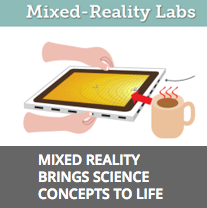Based on a submission by Charles Xie and Jennifer Chiu about their NSF-funded project to integrate sensors and simulations to improve learning.

More than 1,000 middle and high school students in Massachusetts and Virginia have used a novel class of mixed-reality technologies to learn complex science concepts. Leveraging existing software and probeware widely used in schools, these technologies blend virtual and real experiences into a single activity and create a genre of applications with unprecedented learning opportunities.
NSF Project Information
Title: DIP: Collaborative Research: Mixed-Reality Labs: Integrating Sensors and Simulations to Improve Learning
PIs: Charles Xie, Concord Consortium (Award)
Jennifer Chiu, University of Virginia (Award)
One of the reasons that science is difficult for students is because many scientific phenomena are invisible to the naked eye. To help students see science concepts in action in the real world, researchers at the Concord Consortium and the University of Virginia have developed mixed-reality technologies that augment hands-on laboratory activities with sensor-driven computer simulations. These technologies are widely applicable in science education.
For example, the mixed-reality gas laws activity supports deep inquiry into the Kinetic Molecular Theory, a cornerstone of chemistry taught in every school. In this activity, students interact with a visual molecular dynamics simulation of a gas through tactile inputs spatially aligned with objects in the simulation.
“I liked the interactive materials such as the spring and the touch pad to change the temperature. These provided us with tangible objects that changed what was happening on the screen, and it made it more engaging, and thus easier to learn from.”
Students can warm an edge of a tablet computer to “transfer” heat into the virtual gas. Or they can push a real spring visually attached to a virtual piston to “compress” the gas. Or they can use a plunger to “inject” molecules into a virtual chamber. In this way, the technology creates a unique experience as if students could directly manipulate molecules—an experience that is only possible in research labs with advanced nanotechnology instruments.
Anonymous surveys of more than 100 early participants indicated that 80% of students found mixed reality helpful. Interviews with 60 additional students randomly selected from 14 high school classes showed that about 75% of students preferred mixed-reality activities over purely virtual ones. Pre/post-tests demonstrated learning gains for all students. A quasi-experimental study suggested that the mixed-reality gas laws activity was significantly better than traditional lab activities in helping students understand the molecular basis of gas laws.
Learn more on the Mixed-Reality Labs web site.

